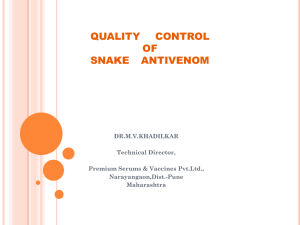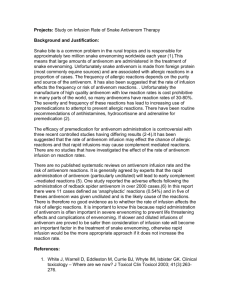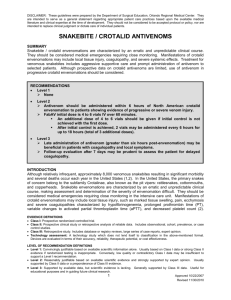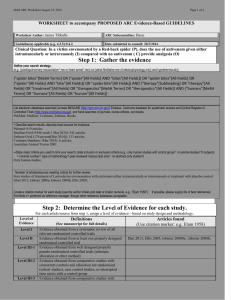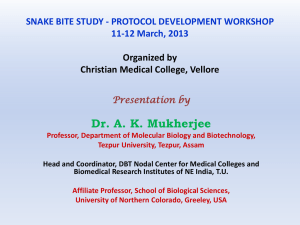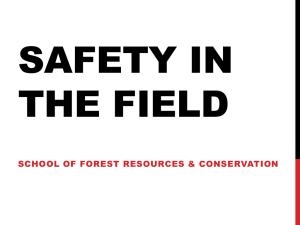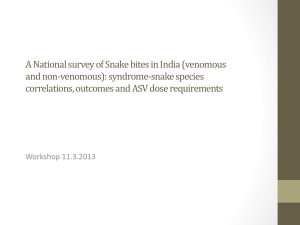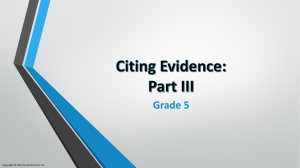snakes_Ridwan 2012
advertisement
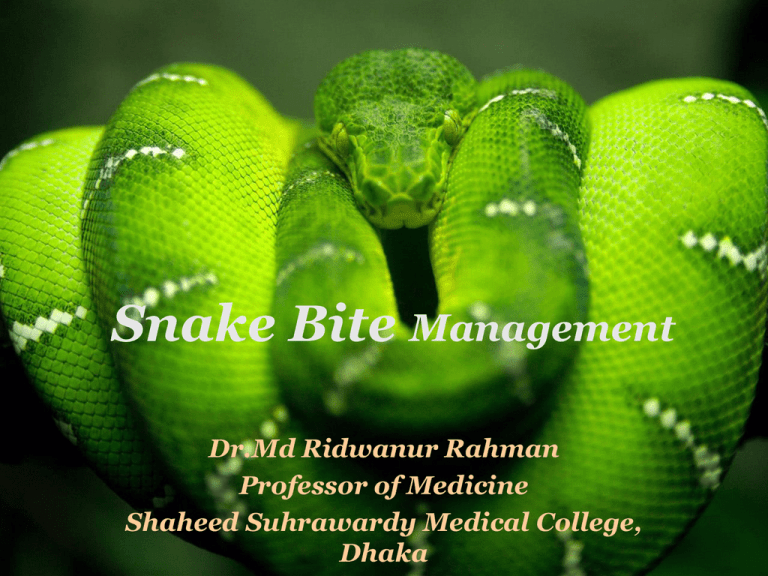
Snake Bite Management Dr.Md Ridwanur Rahman Professor of Medicine Shaheed Suhrawardy Medical College, Dhaka Regional estimates of snakebite envenomings (low estimate) cvUMÖ vg Community Survey nvwZevÜv m›y` i MÄ dzjQwo Annual incidence of snake bite in rural Bangladesh: wRbvMvw_ bvwjZvevox Zvwni cyi ‡dÂyMÄ AvRwgi xMÄ wmsov 623.4/100,000 Person/Yr RwKMÄ QvZK evwbqvPs ¸ i “` vmcyi f vb¸ i v dwi` cyi ‡f ovgvi v Kgj MÄ g‡bvni ` x ‡ej v‡ev Kzgvi Lvj x †nvgbv An estimated 710,159 episodes ‡j ŠnRs SvbwRi v nvRxMÄ ‡j vnvMov gwbi vgcyi ` vgyw`qv Avkvï wb k¨vgbMi dwi` MÄ †PŠÏ MÖ vg Kvwjqv wnRj v ‡Kkecyi Estimated 6,041 death annually MRvwiqv ei Kj KvßvB bj wQwU ‡` Šj ZLvb eveyMÄ evDdj i vRvcyi wgR© vMÄ Pi d¨vkb P‡Kvwiqv g‡nkLvj x PLoS NTD, 2010; 4:10- e860 Snake bite does not have the epidemic potential of infectious and vector-borne parasitic diseases The number of snakebite-induced deaths doubles the NTD mortality figures for this region due to African trypanosomiasis, cholera, dengue haemorrhagic fever, leishmaniasis, Japanese encephalitis and schistosomiasis Important families of venomous snakes in South-East Asia Elapidae Viperidae Early Symptoms and Signs Envenomation Increasing local pain (burning, bursting, throbbing) at the site of the bite Local swelling that gradually extends proximally up the bitten limb and tender painful enlargement of the Regional Lymph nodes. However, bites by kraits and sea snakes may be virtually painless. Local Symptoms and Signs Local pain Local bleeding Fang marks Bruising Lymphangitis LN Enlargement Blistering Local infection & Abscess formation Necrosis Systemic Symptoms General Nausea Vomiting Malaise Abdominal pain Weakness Drowsiness Prostration Cardiovascular Visual disturbances Dizziness Faintness Collapse Shock Hypotension Cardiac arrhythmias Pulmonary oedema Conjunctival oedema (Viperidae) Bleeding and clotting disorders (Viperidae) Bleeding from recent wounds (including fang marks,venepunctures etc) and from old partly-healed wounds Spontaneous systemic bleeding Neurological (Elapidae, Russell’s viper) Drowsiness Paraesthesiae Abnormal taste and smell “Heavy” eyelids,Ptosis,Ext. ophthalmoplegia Facial paralysis Aphonia Difficulty in swallowing secretion Respiratory and generalised flaccid paralysis Rhabdomyolysis Generalised pain, stiffness and tenderness of muscles, trismus, myoglobinuria, hyperkalemia, cardiac arrest, acute renal failure Occur with sea snakes, Russell’s viper Renal (Viperidae, sea snakes) Loin (lower back) pain Haematuria Haemoglobinuria Myoglobinuria Oliguria / Anuria Symptoms and signs of Uraemia Endocrine Acute pituitary/adrenal insuff. with Russell’s viper Acute phase: Shock, Hypoglycaemia Chronic phase (mnths to yrs after): Weakness, Loss of 2ry sexual hair, Amenorrhoea, Testicular atrophy, Hypothyroidism etc Clinical Syndromes of Snake Bite in South-East Asia Syndrome 1 Local envenoming (swelling etc) with bleeding/clotting disturbances Viperidae (all species) Syndrome 2 Local envenoming with bleeding/clotting disturbances, shock or renal failure Russell’s viper +/-saw-scaled viper With conjunctival edema (chemosis) and acute pituitary insufficiency Russell’s viper With Ptosis , External Ophthalmoplegia, facial paralysis etc and dark brown urine Russell’s viper (Sri Lanka & South India) Syndrome 3 Local envenoming (swelling etc) with paralysis Cobra or King Cobra Syndrome 4 Paralysis with minimal or no local envenoming Krait,Sea snake Syndrome 5 Paralysis with dark brown urine and renal failure: With bleeding/clotting disturbance) Russell’s viper (Sri Lanka & South India) No bleeding/clotting disturbances Sea snake Limitations of syndromic approach The range of activities of a particular venom is wide. Considerable overlap of clinical features caused by venoms of different species of snake “Syndromic Approach” may still be useful, especially when the snake has not been identified and only monospecific antivenoms are available. Summary of Manifestations LOCAL NEURO BLEED MISC. COBRA + ++ Nil Shock +/- KRAIT Nil + Nil Pupils – dilated, fixed VIPER +++ +/- ++ Renal failure, Shock Management of snake bite First aid treatment Transport to hospital Rapid clinical assessment and resuscitation Detailed clinical assessment and species diagnosis Investigations/laboratory tests Antivenom treatment Observation of the response to antivenom: decision about the need for further dose(s) of antivenom Supportive/ancillary treatment Treatment of the bitten part Rehabilitation Treatment of chronic complications Aims of First aid To retard systemic absorption of venom Preserve life and prevent complications before receiving medical care Control distressing early symptoms Arrange the transport to a place where they can receive medical care Above all, do no harm Recommended first aid methods Reassure the victim who may be very anxious Immobilise the bitten limb with a splint or sling (any movement or muscular contraction increases absorption of venom into the bloodstream and lymphatics) Consider Pressure-Immobilisation for some elapid bites Avoid any interference with the bite wound as this may introduce infection, increase absorption of the venom and increase local bleeding Pressure immobilisation is recommended for bites by neurotoxic elapid snakes, including sea snakes but should not be used for viper bites because of the danger of increasing the local effects of the necrotic venom. Transport to Hospital Quickly, but as safely and comfortably as possible Any movement, especially of the bitten limb, must be reduced to an absolute minimum to avoid increasing the systemic absorption of venom Any muscular contraction will increase this spread of venom from the site of the bite. Rapid clinical assessment and resuscitation Oxygen IV administration access. ABC The level of consciousness must be assessed. CPR may be needed Early Clues of Severe Envenomation Snake identified as a very dangerous one. Rapid early extension of local swelling. Early tender enlargement of local LN. Early systemic symptoms (hypotension, shock), nausea, vomiting, diarrhoea, severe headache, “heaviness” of the eyelids, inappropriate drowsiness or early ptosis/ophthalmoplegia Early spontaneous systemic bleeding Passage of dark brown urine Patients who become defibrinogenated or thrombocytopenic. Investigations/laboratory tests 20 minute whole blood clotting test (20WBCT) Place a few mls of freshly sampled venous blood in a small glass vessel Leave undisturbed for 20 minutes at ambient temperature Tip the vessel once If the blood is still liquid and runs out, the patient has hypofibrinogenaemia as a result of venom-induced consumption coagulopathy. Platelet count : may be decreased – viper WBC cell count : Early neutrophil leucocytosis in systemic envenoming from any species. Blood film : Fragmented RBC(“helmet cell”, schistocytes) are seen in microangiopathic haemolysis. Plasma/serum : may be pink or brownish if there is gross haemoglobinaemia or myoglobinaemia. Biochemical Abnormalities Aminotransferases, creatine kinase, aldolase elevated if there is severe local damage or, particularly generalised muscle damage. Bilirubin is elevated following massive extravasation of blood. Creatinine, urea or blood urea nitrogen levels are raised in the renal failure. Early hyperkalaemia may be seen following extensive rhabdomyolysis in sea snake bites. Bicarbonate will be low in metabolic acidosis (eg renal failure). Arterial blood gases and pH may show evidence of respiratory failure (neurotoxic envenoming) and acidaemia (respiratory or metabolic acidosis). Arterial puncture is contraindicated in patients with bleeding disorder. Arterial oxygen desaturation can be assessed non-invasively in patients with respiratory failure or shock using a finger oximeter. Urine Examination Dipsticks for blood/ Hb./myoglobin Microscopy for erythrocytes in the urine Red cell casts indicate glomerular bleeding Massive proteinuria is an early sign of the generalised increase in capillary permeability in Russell’s viper envenoming. Antivenom is immunoglobulin (usually the enzyme refined F(ab)2 fragment of IgG) purified from the serum or plasma of a horse or sheep that has been immunised with the venoms of one or more species of snake. Monovalent or monospecific antivenom neutralises the venom of only one species of snake. Polyvalent or polyspecific antivenom neutralises the venoms of several different species of snakes Haffkine, Kasauli, and Serum Institute of India produce “polyvalent anti-snake venom serum” It is raised in horses using the venoms of the “Big four” in India (Indian Cobra,Indian Krait, Russell’s viper,Sawscaled viper). Not included are venoms of King Cobra , Sea snakes and Pitvipers and coral snakes. Antibodies raised against the venom of one species may have cross-neutralising activity against other venoms, usually from closely related species paraspecific activity For example, the manufacturers of Haffkine polyvalent anti-snake venom serum claim that this antivenom also neutralises venoms of two Trimeresurus species Indications for Antivenom Systemic Envenoming Haemostatic abnormalities: Spontaneous systemic bleeding Coagulopathy Thrombocytopenia (<100 x 109/L) Neurotoxic signs: Ptosis, external ophthalmoplegia, paralysis… Cardiovascular abnormalities: Hypotension, shock, cardiac arrhythmia, abnormal ECG Acute renal failure: Oliguria/anuria, rising blood creatinine/urea Haemoglobinuria/myoglobinuria: dark brown urine, evidence of intravascular haemolysis or generalised rhabdomyolysis (muscle aches and pains) Supporting laboratory evidence of systemic envenoming Local Envenoming Local swelling involving more than half of the bitten limb (in the absence of a tourniquet) Swelling after bites on the digits (toes and especially fingers) Rapid extension of swelling (for example beyond the wrist or ankle within a few hours of bites on the hands or feet) Development of an enlarged tender lymph node draining the bitten limb Antivenom treatment is recommended if and when a patient with proven or suspected snake develops one or more of the signs Antivenom treatment should be given as soon as it is indicated.It may reverse systemic envenoming even when this has persisted for several days In the case of haemostatic abnormalities, for 2 or more weeks. When there are signs of local envenoming, without systemic envenoming, antivenom will be effective only if it can be given within the first few hours after the bite. Prediction of Antivenom reactions Skin and conjunctival “hypersensitivity” tests may reveal IgE mediated Type I hypersensitivity to horse or sheep proteins but do not predict the large majority of early (anaphylactic) or late (serum sickness type) antivenom reactions Since they may delay treatment and can in themselves be sensitizing, these tests should not be used. Contraindications to antivenom There is no absolute contraindication to antivenom treatment Patients who have reacted to horse (equine) or sheep (ovine) serum in the past and those with a strong history of atopic diseases (especially severe asthma) should be given antivenom only if they have signs of systemic envenoming. Prophylaxis in high risk patients No drug proved effective in clinical trials High risk patients may be pre-treated empirically with s/c adrenaline, i/v antihistamines (both anti-H1 anti- H2) and corticosteroid. In asthmatic patients, prophylactic use of an inhaled adrenergic Beta2 agonist may prevent bronchospasm. Selection of Antivenom Should be given only if its stated range of specificity includes the species responsible for the bite. Liquid antivenoms that have become opaque should not be used. Provided that antivenom has been properly stored, it can be expected to retain useful activity for many months after the stated “expiry date”. Selection of Antivenom Ideal treatment is monovalent antivenom, as this involves administration of a lower dose of antivenom protein than with a polyvalent antivenoms. Polyspecific antivenoms can be as effective as monospecific ones, but a larger dose of antivenom protein must be administered to neutralise a particular venom. Administration of Antivenom Adrenaline should always be in readiness before antivenom is administered. Antivenom should be given by the intravenous route whenever possible. Freeze-dried (lyophilised) antivenoms are reconstituted, usually with 10 ml of sterile water for injection per ampoule. The freezedried protein may be difficult to dissolve. Grades of Envenomation and Antivenom Treatment Guidelines Grade 0-3 Dry 0 Local effects Systemic Labs effects Skin test Initial AV dose None None Normal No None Mild 1 Confined to bite area None Normal No None Moderate 2 Extends beyond immediate bite area but not all part Mild: vomiting Metabolic taste fasciculations Mild changes: PHYSCIAN DISCRETION 5-10 Severe 3 Involves entire part Severe: Shock, bleeding CNS changes Lethargy, RD , ARF Marked: Rhabdomyolysis Coagulopathies Thrombocytopenia Hypofibrinogenemia High CK As needed PHYSCIAN DISCRETION 15 or more as needed IV “push” Injection Antivenom is given by slow IV inj. (<2 ml/min) This method has the advantage that the doctor/nurse/dispenser giving the antivenom must remain with the patient during the time when some early reactions may develop It is also economical, saving the use of intravenous fluids, giving sets, canula etc. Intravenous Infusion Reconstituted freeze-dried or neat liquid antivenom is diluted in approximately 5-10 ml of isotonic fluid per kg body weight (ie 250-500 ml of isotonic saline or 5% D in the case of an adult patient) and is infused at a constant rate over a period of about one hour. Local administration of antivenom at the site of the bite is not recommended! Although this route may seem rational, it should not be used as it is extremely painful may increase intracompartmental pressure and has not been shown to be effective. Antivenom must never be given by the intramuscular route if it could be given intravenously. Antivenom reactions Early anaphylactic reactions: usually within 10-180 minutes of starting antivenom the patient begins to itch (often over the scalp) and develops urticaria, dry cough,fever, nausea, vomiting, abdominal colic, diarrhoea and tachycardia A minority of these patients may develop severe life-threatening anaphylaxis: Hypotension,bronchospasm and angio-oedema. In most cases, these reactions are not truly “allergic”. They are not IgE-mediated type I hypersensitivity reactions to horse or sheep proteins. Pyrogenic (endotoxin) reactions Are common & usually develop 1-2 hours after treatment. Symptoms include shaking chills (rigors), fever, vasodilatation and a fall in BP Febrile convulsions may be precipitated in children & are caused by pyrogen contamination during the manufacturing process Late (serum sickness type) reactions develop 1 - 12 (mean 7) days after treatment. Clinical features include fever, nausea, vomiting, diarrhoea, itching, recurrent urticaria, arthralgia, myalgia, lymphadenopathy, periarticular swellings, mononeuritis multiplex. At the earliest sign of a reaction: Antivenom administration must be temporarily suspended Epinephrine (adrenaline) (0.1% solution, 1 in 1,000, 1 mg/ml) is effective Treatment of late reactions Doses: Chlorpheniramine: adults 2 mg six hourly, children 0.25 mg/kg in divided doses In those who fail to respond Prednisolone: adults 5 mg six hourly, children 0.7 mg/kg/day in divided doses 5-7 days Observation of the response to antivenom Nausea, headache and generalised aches and pains may disappear very quickly. Spontaneous systemic bleeding (eg from the gums) usually stops within 15-30 minutes. In shocked patients, blood pressure may increase within the first 30-60 minutes and arrhythmias such as sinus bradycardia may resolve. Blood coagulability (as measured by 20WBCT) is usually restored in 3-9 hours. Bleeding from new and partly healed wounds usually stops much sooner than this. Active haemolysis and rhabdomyolysis may cease within a few hours and the urine returns to its normal colour. Recurrence of systemic envenoming Signs of systemic envenoming may recur in 24-48 hrs This is attributable to: (1) continuing absorption of venom from the “depot” at the site of the bite, (2) a redistribution of venom from the tissues into the vascular space, as the result of antivenom treatment. Criteria for giving more antivenom Persistence or recurrence of blood incoagulability after 6 hr Deteriorating neurotoxic or cardiovascular signs after 1-2 hr. If the blood remains incoagulable (as measured by 20WBCT) six hours after the initial dose of antivenom, the same dose should be repeated. This is based on the observation that, if a large dose of antivenom given initially, the time taken for the liver to restore coagulable levels of fibrinogen and other clotting factors is 3-9 hours. In patients who continue to bleed briskly, the dose of antivenom should be repeated within 1-2 hours. In case of deteriorating neurotoxicity or cardiovascular signs, the initial dose of antivenom should be repeated after 1-2 hours, and full supportive treatment must be considered. Conservative treatment when no antivenom is available When Bite antivenom is unavailable by a species against whose venom there is no available specific antivenom (for example coral snakes - genera, sea snakes) Neurotoxic envenoming with respiratory paralysis Assisted ventilation has proved effective Anticholinesterases always be tried should Hemostatic abnormalities Strict bed rest to avoid even minor trauma transfusion of clotting factors and platelets; ideally, fresh frozen plasma with platelet concentrates or, if these are not available, fresh whole blood. Intramuscular injections should be avoided. Shock,Myocardial damage Hypovolaemia should be corrected with colloid/crystalloids, controlled by observation of the central venous pressure Ancillary pressor drugs (dopamine or epinephrine-adrenaline) Hypotension associated with bradycardia should be treated with atropine. Renal failure: conservative treatment or dialysis Myoglobinuria or haemoglobinuria: correct hypovolaemia and acidosis and consider a single infusion of mannitol Neurotoxic envenoming Antivenom treatment alone cannot be relied upon to save the life of a patient with bulbar and respiratory paralysis. Death may result from aspiration, airway obstruction or respiratory failure. A clear airway must be maintained. Cuffed ET tube should be inserted. Tracheostomy may be needed. Treatment of the bitten part Keep slightly elevated, to encourage reabsorption of oedema fluid Bullae may be large and tense but they should be aspirated only if they seem likely to rupture. Bacterial infections Prophylactic course of penicillin (or erythromycin for penicillinhypersensitive patients)and a single dose of gentamicin or a course of chloramphenicol Booster dose of tetanus toxoid is recommended. Five Key Focus Areas • Prevention, Community Education & Pre-hospital Care – Low cost per capita interventions • Surveillance & Reporting, Clinical & Lab. Research – Informing debate & resource allocation and deploying technology • Education & Training, Improved Medical Management – Getting maximum value from therapeutic care • Immunotherapeutics – Establishing simple, cheap methods of immunodiagnosis – Optimising antivenom production, ensuring safety & efficacy • Rehabilitation from Disability – Repairing shattered lives, advocating basic human rights, restoring opportunity, human dignity and independence
